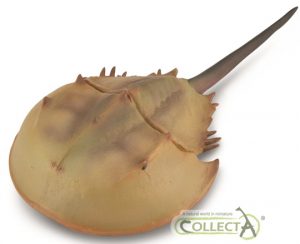The Incredible and Adaptable Horseshoe Crab
The Ancient Horseshoe Crab
A member of the phylum known as the Arthropoda, Horseshoe crabs have not changed over millions of years. The first fossils of these tough, marine creatures have been dated to around 450 million years ago (Katian faunal stage of the Upper Ordovician). Superficially they resemble crustaceans such as crabs and lobsters but in fact they are more closely related to arachnids (spiders, mites and scorpions). Horseshoe crabs are therefore not closely related to crabs, despite their common name. Indeed, these animals are classified into the subphylum called Chelicerata (the term means claws and horns and relates to the structure of the mouth parts).
Horseshoe Crab
A Model of an Extant Horseshoe Crab (CollectA Prehistoric Life Model Range)
A beautifully preserved Horseshoe crab fossil from south-western China (Luoping Formation). Fossils in photographs probably date from the Early Triassic and are perhaps more than 240 million years old.
There are four known species of Horseshoe crab, three can be found in south-east Asian waters whilst the fourth species can be found in the Gulf of Mexico and on the Atlantic coast of the United States. All four species are believed to be endangered due to over fishing, loss of suitable breeding beaches and pollution.
To view the CollectA Prehistoric Life model range: CollectA Prehistoric Life Models and Figures.


